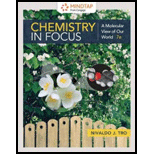
Concept explainers
Interpretation:
The most common oxidizing agents and reducing agents, along with their respective reactions, are to be discussed.
Concept Introduction:
Oxidation is the addition of an electronegative element and the removal of an electropositive element in a
Reduction is the addition of an electropositive element and the removal of an electronegative element in a chemical reaction.
A chemical reaction in which oxidation process and reduction process takes place simultaneously is called a redox reaction.
An oxidizing agent is a substance that has the capacity to oxidize another substance, and to get reduced, in a chemical reaction.
A reducing agent is a substance that has the capacity to reduce another substance, and to get oxidized, in a chemical reaction.
Answer to Problem 10E
Solution:
The most common oxidizing agents are oxygen, chlorine and hydrogen peroxide. Oxygen is used as an oxidizing agent in redox reactions, such as the combustion of gasoline in automobiles and the burning of wood in the presence of fire. Chlorine is used as an oxidizing agent in the formation of bleaching powder, which is used as a disinfectant in drinking water.
The most common reducing agents are carbon, hydrogen and carbon monoxide. Hydrogen is used as a reducing agent in the reduction of nitrogen into ammonia. Carbon is a reducing agent; it is used in the reduction of metal ores into their respective metals. Carbon monoxide is a reducing agent. It is used in the reduction of iron oxide into iron.
Explanation of Solution
An oxidizing agent is a substance that tends to gain electrons in a redox reaction. It oxidizes the other substance and gets reduced in a redox reaction. It is also known as the electron acceptor and the oxidation state increases. The most common oxidizing agents are oxygen, chlorine, iodine and hydrogen peroxide. Chlorine is used as an oxidizing agent for the production of bleaching powder. It is also used as anantiseptic.
The equation for the reaction of
An oxidizing agent gains electron easily while a reducing agent loses electrons easily in a redox reaction.
In this chemical reaction, the oxidation state of
Oxygen is used as an oxidizing agent for the oxidation of sugar in respiration.
The chemical equation for the respiration reaction is as follow:
An oxidizing agent gains electron easily while a reducing agent loses electrons easily in a redox reaction.
In this chemical reaction, the oxidation state of
In this chemical reaction, the oxidation state of
A reducing agent is a substance that tends to lose electrons in an oxidation-reduction reaction. It reduces the other substance and gets oxidized in a redox reaction. It is also known as the electron donor and the oxidation state of the substances decreases.
The common reducing agents are hydrogen, carbon monoxide and carbon.
Hydrogen is used as a reducing agent. It is used for the reduction of nitrogen into ammonia as follow:
An oxidizing agent gains electron easily while a reducing agent loses electrons easily in a redox reaction.
In this chemical reaction, the oxidation state of
In this chemical reaction, the oxidation state of
Carbon monoxide is used as a reducing agent. It is used for the reduction of iron ore into iron.
The equation for the reaction of
An oxidizing agent gains electron easily while a reducing agent loses electrons easily in a redox reaction.
In this chemical reaction, the oxidation state of
In this chemical reaction, the oxidation state of
Carbon is used as a reducing agent. It is used for the reduction of nickel oxide into nickel.
The equation for the reaction of
Oxidation is the loss of electrons and gain of oxygen in a chemical reaction. Reduction is the gain of electrons and loss of oxygen in a chemical reaction.
In this chemical reaction, the oxidation state of
In this chemical reaction, the oxidation state of
Oxygen, chlorine and hydrogen peroxide are the most common oxidizing agents, whereas the most common reducing agents are hydrogen, carbon monoxide and carbon.
Want to see more full solutions like this?
Chapter 14 Solutions
Owlv2 With Mindtap Reader, 1 Term (6 Months) Printed Access Card For Tro's Chemistry In Focus: A Molecular View Of Our World, 7th
- help 20arrow_forwardProvide the drawing of the unknown structure that corresponds with this data.arrow_forward20.44 The Diels-Alder reaction is not limited to making six-membered rings with only car- bon atoms. Predict the products of the following reactions that produce rings with atoms other than carbon in them. OCCH OCCH H (b) CH C(CH₂)s COOCH མ་ནས་བ (c) N=C H -0.X- (e) H C=N COOCHS + CH2=CHCH₂ →→arrow_forward
- 3) Draw a detailed mechanism and predict the product of the reaction shown? 1) EtMgBr 2) H3O+arrow_forwardHow to draw the mechanism for this reaction?arrow_forward> H₂C=C-CH2-CH3 B. H₂O Pt C. + H2 + H₂O H D. 16. Give the IUPAC name for each of the following: B. Cl Cl c. Cl Cl 17. Draw the line-angle formula for each of the following compounds: 1. phenol 2. 1,3-dichlorobenzene 3. 4-ethyltoluene < Previous Submit Assignment Next ▸arrow_forward

 Chemistry: The Molecular ScienceChemistryISBN:9781285199047Author:John W. Moore, Conrad L. StanitskiPublisher:Cengage LearningChemistry: Matter and ChangeChemistryISBN:9780078746376Author:Dinah Zike, Laurel Dingrando, Nicholas Hainen, Cheryl WistromPublisher:Glencoe/McGraw-Hill School Pub Co
Chemistry: The Molecular ScienceChemistryISBN:9781285199047Author:John W. Moore, Conrad L. StanitskiPublisher:Cengage LearningChemistry: Matter and ChangeChemistryISBN:9780078746376Author:Dinah Zike, Laurel Dingrando, Nicholas Hainen, Cheryl WistromPublisher:Glencoe/McGraw-Hill School Pub Co World of Chemistry, 3rd editionChemistryISBN:9781133109655Author:Steven S. Zumdahl, Susan L. Zumdahl, Donald J. DeCostePublisher:Brooks / Cole / Cengage Learning
World of Chemistry, 3rd editionChemistryISBN:9781133109655Author:Steven S. Zumdahl, Susan L. Zumdahl, Donald J. DeCostePublisher:Brooks / Cole / Cengage Learning Chemistry: Principles and PracticeChemistryISBN:9780534420123Author:Daniel L. Reger, Scott R. Goode, David W. Ball, Edward MercerPublisher:Cengage Learning
Chemistry: Principles and PracticeChemistryISBN:9780534420123Author:Daniel L. Reger, Scott R. Goode, David W. Ball, Edward MercerPublisher:Cengage Learning Chemistry & Chemical ReactivityChemistryISBN:9781337399074Author:John C. Kotz, Paul M. Treichel, John Townsend, David TreichelPublisher:Cengage Learning
Chemistry & Chemical ReactivityChemistryISBN:9781337399074Author:John C. Kotz, Paul M. Treichel, John Townsend, David TreichelPublisher:Cengage Learning





